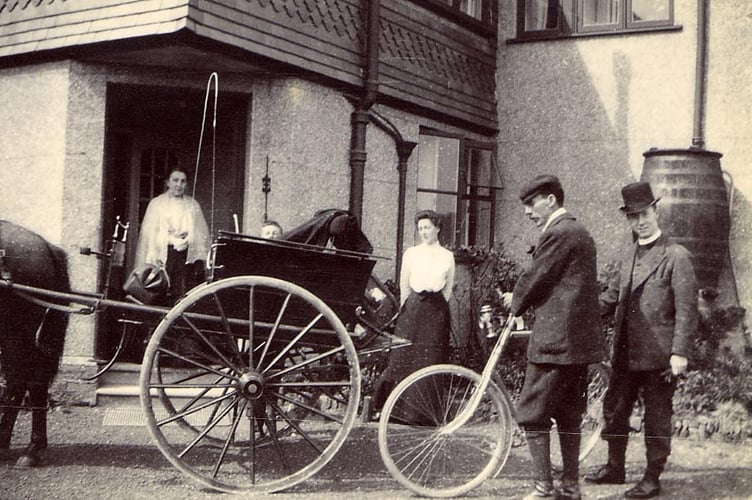Top Stories
Bicycles Challenged Tradition in 1896: A Look Back at Controversies

The rise of bicycles in the late 19th century sparked significant debate and controversy, as the mode of transport began to replace traditional horse-drawn vehicles. In an article published on August 29, 1896, the Farnham Weekly Herald highlighted the rapid increase in bicycle popularity, which was seen as a disruption to established norms. The correspondent noted, “It is quite simply astonishing, the way the bicycle is displacing the horse.”
As bicycles gained traction, local governments responded with regulations to ensure safety. In Middlesex, a bylaw was enacted mandating that all vehicles carry lighted lamps during twilight hours. This change reflected growing concerns over the safety of cyclists as they shared the roads with other forms of transportation.
The trend was not confined to Britain. The article also mentioned a new market dedicated solely to bicycles that had opened in Paris. The correspondent expressed skepticism about its potential success, stating, “The idea is a good one, but I doubt if the income, even in cycling Paris, will be large enough to make the market a financial success.”
While the bicycle movement represented a step toward modern transport, it also highlighted gender disparities in society. The Farnham Weekly Herald reported that female bicycle racing faced resistance in Canada, where authorities attempted to suppress such events. Despite efforts to ban female races, several had taken place, prompting the board to threaten to blacklist venues allowing women to compete publicly. This echoed broader societal tensions regarding women’s rights during that era.
As cyclists navigated the challenges of increased visibility, tensions with other transport users escalated. Reports from Willesden Junction described a porter who had contemptuously discarded a bicycle frame, illustrating the growing friction between cyclists and railway workers. Similarly, at Victoria Station, a guard was noted to have deliberately damaged a bicycle by breaking off its pedal. The writer lamented, “How doth the festive railway man improve his pensive hours by doing everything he can to smash those bikes of ours,” emphasizing the animosity cyclists faced in public spaces.
The debates around the bicycle in the 1890s reveal a snapshot of a society in transition. As bicycles became symbols of freedom and mobility, they also highlighted existing societal divides and resistance to change. The friction between cyclists, traditional transport methods, and gender roles reflected broader cultural shifts taking place at the time, marking an important chapter in the history of transportation.
Looking back at this period provides valuable insights into the complexities of technological advancement and social dynamics, especially as societies continue to grapple with similar discussions surrounding sustainable transport and equality today.
-

 Health2 months ago
Health2 months agoNeurologist Warns Excessive Use of Supplements Can Harm Brain
-

 Health2 months ago
Health2 months agoFiona Phillips’ Husband Shares Heartfelt Update on Her Alzheimer’s Journey
-

 Science2 weeks ago
Science2 weeks agoBrian Cox Addresses Claims of Alien Probe in 3I/ATLAS Discovery
-

 Science2 weeks ago
Science2 weeks agoNASA Investigates Unusual Comet 3I/ATLAS; New Findings Emerge
-

 Science1 week ago
Science1 week agoScientists Examine 3I/ATLAS: Alien Artifact or Cosmic Oddity?
-

 Entertainment4 months ago
Entertainment4 months agoKerry Katona Discusses Future Baby Plans and Brian McFadden’s Wedding
-

 Science1 week ago
Science1 week agoNASA Investigates Speedy Object 3I/ATLAS, Sparking Speculation
-

 World2 months ago
World2 months agoCole Palmer’s Cryptic Message to Kobbie Mainoo Following Loan Talks
-

 Entertainment3 months ago
Entertainment3 months agoEmmerdale Faces Tension as Dylan and April’s Lives Hang in the Balance
-

 Science1 week ago
Science1 week agoNASA Scientists Explore Origins of 3I/ATLAS, a Fast-Moving Visitor
-

 Entertainment4 months ago
Entertainment4 months agoLove Island Star Toni Laite’s Mother Expresses Disappointment Over Coupling Decision
-

 Entertainment2 months ago
Entertainment2 months agoMajor Cast Changes at Coronation Street: Exits and Returns in 2025









